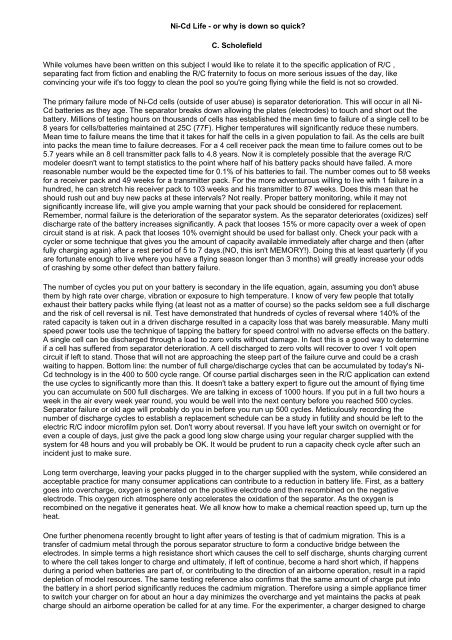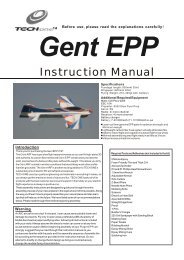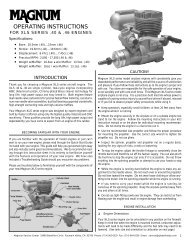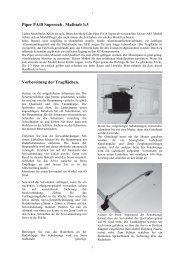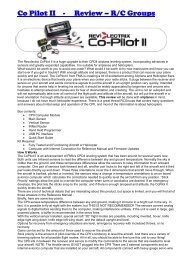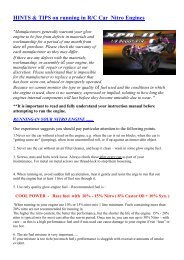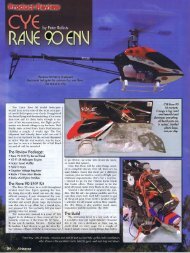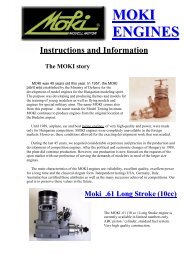Create successful ePaper yourself
Turn your PDF publications into a flip-book with our unique Google optimized e-Paper software.
Ni-Cd Life - or why is down so quick?C. ScholefieldWhile volumes have been written on this subject I would like to relate it to the specific application <strong>of</strong> R/C ,separating fact from fiction and enabling the R/C fraternity to focus on more serious issues <strong>of</strong> the day, likeconvincing your wife it's too foggy to clean the pool so you're going flying while the field is not so crowded.The primary failure mode <strong>of</strong> Ni-Cd cells (outside <strong>of</strong> user abuse) is separator deterioration. This will occur in all Ni-Cd batteries as they age. The separator breaks down allowing the plates (electrodes) to touch and short out thebattery. Millions <strong>of</strong> testing hours on thousands <strong>of</strong> cells has established the mean time to failure <strong>of</strong> a single cell to be8 years for cells/batteries maintained at 25C (77F). Higher temperatures will significantly reduce these numbers.Mean time to failure means the time that it takes for half the cells in a given population to fail. As the cells are builtinto packs the mean time to failure decreases. For a 4 cell receiver pack the mean time to failure comes out to be5.7 years while an 8 cell transmitter pack falls to 4.8 years. Now it is completely possible that the average R/Cmodeler doesn't want to tempt statistics to the point where half <strong>of</strong> his battery packs should have failed. A morereasonable number would be the expected time for 0.1% <strong>of</strong> his batteries to fail. The number comes out to 58 weeksfor a receiver pack and 49 weeks for a transmitter pack. For the more adventurous willing to live with 1 failure in ahundred, he can stretch his receiver pack to 103 weeks and his transmitter to 87 weeks. Does this mean that heshould rush out and buy new packs at these intervals? Not really. Proper battery monitoring, while it may notsignificantly increase life, will give you ample warning that your pack should be considered for replacement.Remember, normal failure is the deterioration <strong>of</strong> the separator system. As the separator deteriorates (oxidizes) selfdischarge rate <strong>of</strong> the battery increases significantly. A pack that looses 15% or more capacity over a week <strong>of</strong> opencircuit stand is at risk. A pack that looses 10% overnight should be used for ballast only. Check your pack with acycler or some technique that gives you the amount <strong>of</strong> capacity available immediately after charge and then (afterfully charging again) after a rest period <strong>of</strong> 5 to 7 days.(NO, this isn't MEMORY!). Doing this at least quarterly (if youare fortunate enough to live where you have a flying season longer than 3 months) will greatly increase your odds<strong>of</strong> crashing by some other defect than battery failure.The number <strong>of</strong> cycles you put on your battery is secondary in the life equation, again, assuming you don't abusethem by high rate over charge, vibration or exposure to high temperature. I know <strong>of</strong> very few people that totallyexhaust their battery packs while flying (at least not as a matter <strong>of</strong> course) so the packs seldom see a full dischargeand the risk <strong>of</strong> cell reversal is nil. Test have demonstrated that hundreds <strong>of</strong> cycles <strong>of</strong> reversal where 140% <strong>of</strong> therated capacity is taken out in a driven discharge resulted in a capacity loss that was barely measurable. Many multispeed power tools use the technique <strong>of</strong> tapping the battery for speed control with no adverse effects on the battery.A single cell can be discharged through a load to zero volts without damage. In fact this is a good way to determineif a cell has suffered from separator deterioration. A cell discharged to zero volts will recover to over 1 volt opencircuit if left to stand. Those that will not are approaching the steep part <strong>of</strong> the failure curve and could be a crashwaiting to happen. Bottom line: the number <strong>of</strong> full charge/discharge cycles that can be accumulated by today's Ni-Cd technology is in the 400 to 500 cycle range. Of course partial discharges seen in the R/C application can extendthe use cycles to significantly more than this. It doesn't take a battery expert to figure out the amount <strong>of</strong> flying timeyou can accumulate on 500 full discharges. We are talking in excess <strong>of</strong> 1000 hours. If you put in a full two hours aweek in the air every week year round, you would be well into the next century before you reached 500 cycles.Separator failure or old age will probably do you in before you run up 500 cycles. Meticulously recording thenumber <strong>of</strong> discharge cycles to establish a replacement schedule can be a study in futility and should be left to theelectric R/C indoor micr<strong>of</strong>ilm pylon set. Don't worry about reversal. If you have left your switch on overnight or foreven a couple <strong>of</strong> days, just give the pack a good long slow charge using your regular charger supplied with thesystem for 48 hours and you will probably be OK. It would be prudent to run a capacity check cycle after such anincident just to make sure.Long term overcharge, leaving your packs plugged in to the charger supplied with the system, while considered anacceptable practice for many consumer applications can contribute to a reduction in battery life. First, as a batterygoes into overcharge, oxygen is generated on the positive electrode and then recombined on the negativeelectrode. This oxygen rich atmosphere only accelerates the oxidation <strong>of</strong> the separator. As the oxygen isrecombined on the negative it generates heat. We all know how to make a chemical reaction speed up, turn up theheat.One further phenomena recently brought to light after years <strong>of</strong> testing is that <strong>of</strong> cadmium migration. This is atransfer <strong>of</strong> cadmium metal through the porous separator structure to form a conductive bridge between theelectrodes. In simple terms a high resistance short which causes the cell to self discharge, shunts charging currentto where the cell takes longer to charge and ultimately, if left <strong>of</strong> continue, become a hard short which, if happensduring a period when batteries are part <strong>of</strong>, or contributing to the direction <strong>of</strong> an airborne operation, result in a rapiddepletion <strong>of</strong> model resources. The same testing reference also confirms that the same amount <strong>of</strong> charge put intothe battery in a short period significantly reduces the cadmium migration. Therefore using a simple appliance timerto switch your charger on for about an hour a day minimizes the overcharge and yet maintains the packs at peakcharge should an airborne operation be called for at any time. For the experimenter, a charger designed to charge


